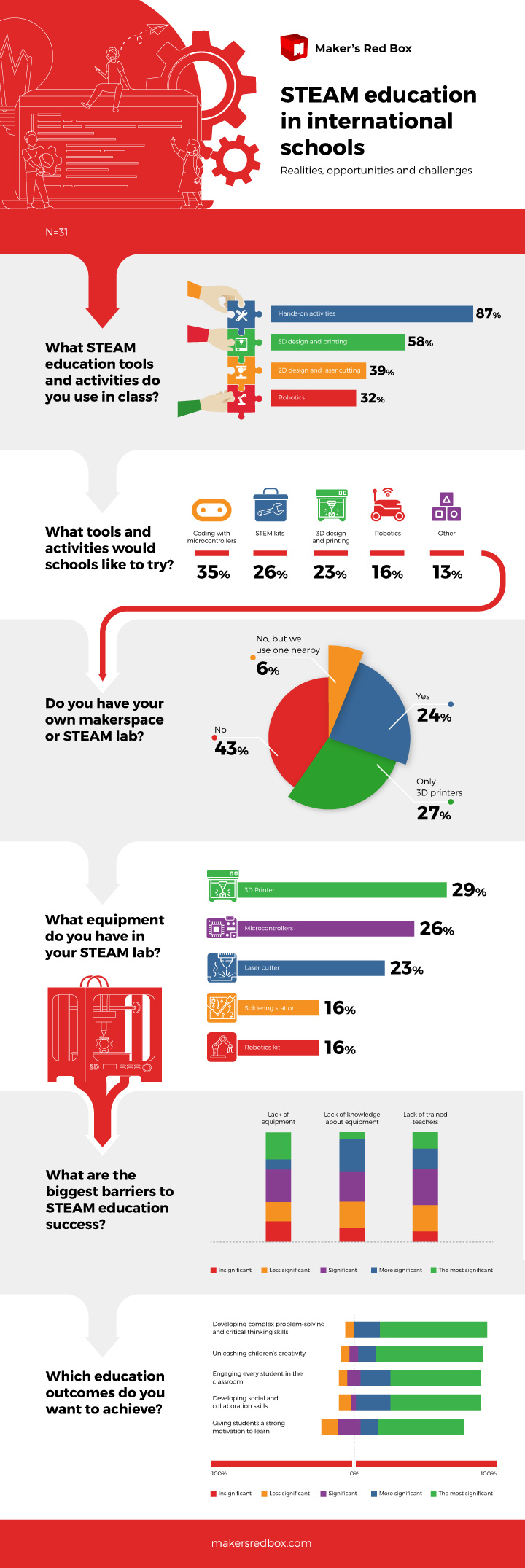We’ve asked 30+ head teachers about STEAM education. Here’s what they had to say
Makers Red Box 2022. 01. 31. 08:45
Analytical thinking, creativity, critical thinking, emotional intelligence and complex problem-solving: these are shaping up to be the most in-demand skills this year, as forecast by the World Economic Forum. These competencies, however, aren’t exactly what most schools, or even education systems for that matter, have traditionally been looking to develop. Will we see the tide turn in 2022? Are educators ready to embrace new teaching and learning methods to prepare today’s students for an increasingly connected and automated future? If yes, what tools and strategies are they using to combat this challenge? And just as importantly, how will they translate ambition into action? These were the questions we wanted to uncover when we asked head teachers of over thirty international schools across the globe, from Denmark to Kuwait. Here’s what we found out.
Project- and problem-based learning, 3D printing on the rise
Over two-thirds of respondents said they were intrigued by what project-based learning can bring to the table, with problem-based learning (58 %) drawing similar levels of attention. “Wait, aren’t these the same thing?” you might wonder. Not quite. They both promote active, collaborative and learner-centred education, but in project-based learning, students’ task is to create an end product to show what they’ve learned, while in problem-based learning, they need to come up with a solution to a problem that determines what they study.
Learning by doing came in third in popularity but topped the list of STEAM activities respondents said they had introduced into the classroom with 87%.
On the technology front, 3D design and printing is used in class by nearly two in three schools, while 2D design and laser cutting by over one in three.

According to a recent MakerBot survey of over 1,000 education professionals in more than 60 countries, the importance of additive manufacturing in education has been steadily growing over the past year. This is no small feat in the face of widespread school shutdowns that occurred during this period due to the coronavirus pandemic. Fifty-seven percent of respondents stated that they used the technology to create student-designed prototypes as part of problem-based learning projects and 36% to increase engagement.
This sentiment was echoed by our participants. When asked why they had decided or planned to make STEAM tools and activities part of classroom instruction, many of them cited their effectiveness in promoting active, experiential learning, enhancing the learning experience and boosting motivation. “This approach is based on the belief that students should be put at the centre of the teaching and learning process and that learning is the most effective when children are engaged in meaningful activities,” said one head teacher.
Lab study: tools and training are a must for better outcomes
Thirty percent of respondents either said that their school was equipped with a digital workshop, whether a makerspace, fablab or innovation lab, or it used a nearby facility, signalling the adoption of a broader focus on STEAM education that goes beyond 3D printing. But many of them feel that with more investment in technology and training, a lot more could be done. “Our school offers robotics and F1 programmes and has a CNC milling machine and a printer that students can use to design and build machine parts. But I’d love students to have more opportunities to learn programming as part of these classes,” explained one of the respondents.
For schools that aren’t willing to evolve to meet future business demands, the writing is on the wall. Most survey participants seem to be well aware of this, with
75% claiming that developing complex problem-solving and critical thinking skills and unleashing children’s creativity are top-of-agenda issues for their institutions.
One respondent explained, “More than anything else, I want to teach students how to be adaptable. They must be able to learn new skills and find ways to solve a variety of problems because this is what they will be doing for the rest of their lives. I want to see them equipped to do anything.”
About the survey
With the survey, our goal was to understand schools’ attitudes towards STEAM education, including the opportunities and challenges involved. Asked between September and December 2021, the 31 respondents identified themselves as head teachers of international schools in Denmark, Finland, Sweden, Norway, the Netherlands, Latvia, Switzerland, Palestine, Azerbaijan, Kuwait and the United Arab Emirates.

